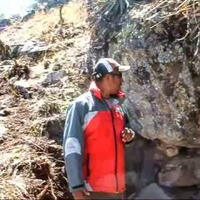Bebel Ibarra
Tulane University, Anthropology, Adjunct
- Archaeology, Andean Archaeology, Andean Prehistory (Archaeology), Andean Culture, Physical Anthropology, Andean studies, and 21 morePeruvian Archaeology, Sacred Landscape (Archaeology), Inca Archaeology, Bioarchaeology, Landscape Archaeology, Incas, Anthropology, Andes, Archaeology of Ritual and Magic, Inkas, Andean History, Anthropology of Peru, Formative Andean archaeology, Arqueología Andina, Arqueología Inka, South American Archaeology, Pre-Hispanic Complex Cultures of the Andes, Archeology, New Materialism, Tiwanaku, and South America (Archaeology)edit
The archaeological study of mortuary variability is an important component of the examination of ancient sociopolitical organization. Tombs were spaces of negotiation, kinship formation and rituality. In the Central Andes of Peru,... more
The archaeological study of mortuary variability is an important component of the examination of ancient sociopolitical organization. Tombs were spaces of negotiation, kinship formation and rituality. In the Central Andes of Peru, investigations of mortuary variation have focused on the study of cults of the dead, and ancestor veneration.
Research Interests:
Research Interests:
Research Interests:
This presentation will show the results of my ongoing research at the site of Huamparán located 25 km north of Chavín de Huantar. At Huamparán, several rhomboidal hearths were found in large rectangular enclosures that surround patio... more
This presentation will show the results of my ongoing research at the site of Huamparán located 25 km north of Chavín de Huantar. At Huamparán, several rhomboidal hearths were found in large rectangular enclosures that surround patio spaces. Ceramic and radiocarbon dating place their construction between the Early Intermediate Period and Middle Horizon. Comparisons with the Recuay occupation of Chavín de Huántar and Pashash indicate that this type of hearth is common at Recuay settlements in the north-central highlands.
The use of hearths has a long history in the central Andes (i.e. Mito or Kotosh Religious Tradition). Rhomboidal hearths like those from Huamparán are also present at Chavin de Huantar. Their presence at Huamparan raises the question: where did the Recuay people get this tradition?, Was it replicated in from much earlier versions (i.e. Mito) and later used by people from Huamparán, or was it a local Recuay expression that spread to different parts of the north-central highlands??
The use of hearths has a long history in the central Andes (i.e. Mito or Kotosh Religious Tradition). Rhomboidal hearths like those from Huamparán are also present at Chavin de Huantar. Their presence at Huamparan raises the question: where did the Recuay people get this tradition?, Was it replicated in from much earlier versions (i.e. Mito) and later used by people from Huamparán, or was it a local Recuay expression that spread to different parts of the north-central highlands??
A.R. Titelbaum,∗, B. Ibarra, S. Naji
Research Interests:
Luis Andrade Ciudad
Research Interests:
Nathan D. Stansell a,*, Donald T. Rodbell b, Mark B. Abbott c, Bryan G. Mark a,d
Research Interests:
Magdalena Chocano
Research Interests:
EMMA POMEROY,a* JAY T. STOCK,a
SONIA R. ZAKRZEWSKIb AND MARTA MIRAZO´ N LAHRa
SONIA R. ZAKRZEWSKIb AND MARTA MIRAZO´ N LAHRa
Research Interests:
Research Interests:
Strontium isotope (87Sr/86Sr) analysis of human skeletal remains is an important method in archaeology to examine past human mobility and landscape use. 87Sr/86Sr signatures of a given location are largely determined by the underlying... more
Strontium isotope (87Sr/86Sr) analysis of human skeletal remains is an important method in archaeology to examine past human mobility and landscape use. 87Sr/86Sr signatures of a given location are largely determined by the underlying bedrock, and these geology specific isotope signatures are incorporated into skeletal tissue through food and water, often permitting the differentiation of local and non-local individuals in past human populations. This study presents the results of a systematic survey of modern flora and fauna (n = 100) from 14 locations to map the bioavailable 87Sr/86Sr signatures of the Conchucos region, an area where the extent of geologic variability was previously unknown. We illustrate the necessity to examine the variation in 87Sr/86Sr values of the different geological formations available to human land use to document the range of possible local 87Sr/86Sr values. Within the Conchucos region we found significant variation in environmental 87Sr/86Sr values (0....
Research Interests:
Research Interests:
Se desarrolla el concepto de identidad espiritual en los Andes centrales de comienzos del siglo XVII, el que surge a partir de la relación que se genera entre una comunidad y su ser protector, y de cómo dicha identidad espiritual... more
Se desarrolla el concepto de identidad espiritual en los Andes centrales de comienzos del siglo XVII, el que surge a partir de la relación que se genera entre una comunidad y su ser protector, y de cómo dicha identidad espiritual constituye la base de la organización social al interior de una comunidad, así como a la vez, genera los principios de articula-ción de las etnicidades. Como una forma metodológica de abordar el tema, se proponen distintos niveles de identidad espiritual, dependiendo de la amplitud del grupo social involucrado, situación que conlleva a un proceso de identidades múltiples, inclusivas y complementarias.
Daniel Llanos Jacinto
